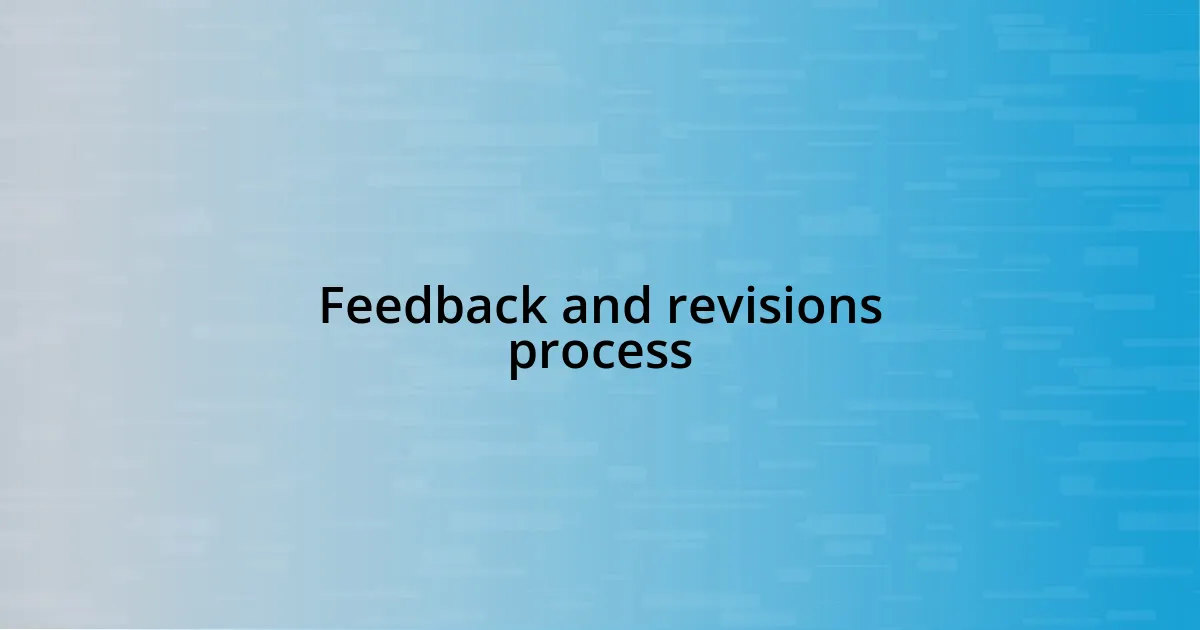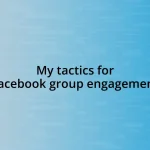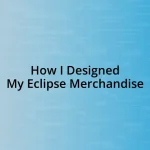Key takeaways:
- The logo design was inspired by the beauty of solar eclipses and childhood interest in astronomy, emphasizing emotional connection and movement.
- Key design principles include simplicity, relevance, versatility, memorability, and timelessness to create an effective logo.
- Feedback and revisions were crucial in refining the design, highlighting the importance of external perspectives for improvement.
- Presenting the logo effectively involves clarity, storytelling, and appropriate context to enhance audience engagement and understanding.

Inspiration for the eclipse logo
The inspiration for my eclipse logo stemmed from the awe-inspiring moments I experienced during various solar eclipses. Each time the moon seamlessly slid in front of the sun, I was reminded of the delicate balance in nature and how fleeting yet breathtaking these events are. Isn’t it fascinating how something as simple as the alignment of celestial bodies can evoke such deep feelings of wonder?
I also drew inspiration from my childhood fascination with astronomy. I remember eagerly awaiting nights when my family would set up a telescope in our backyard, looking through the lens, hoping to catch a glimpse of something extraordinary. That sense of anticipation and excitement shaped my design philosophy, infusing the logo with a sense of movement and energy that mirrors the experience of watching an eclipse unfold.
Additionally, incorporating contrasting colors was central to my vision. The stark difference between the dark silhouette of the moon and the bright rays of the sun captivated me as a child. It made me think: how can colors convey emotions just as vividly as images? By using this contrast, I aimed to capture not just the visual spectacle of an eclipse but the emotional experience it brings—making the viewer pause and appreciate the beauty of this natural phenomenon.

Design principles for logo creation
Creating a logo involves much more than just putting shapes and colors together; it’s about conveying a message. I remember when I first started designing logos, I often overlooked the underlying principles that make a design effective. Each element should serve a purpose, whether that’s representing the brand’s identity or evoking a particular feeling. A strong logo is simple, memorable, and timeless, capturing the essence of what it stands for.
Here are some key design principles to keep in mind:
- Simplicity: Keep it clean and uncomplicated to ensure it’s easily recognizable.
- Relevance: Align the design with the brand’s message and values to create a connection.
- Versatility: Design should look good in various sizes and formats, from business cards to billboards.
- Memorability: Aim for a unique design that sticks in people’s minds, making it stand out in a crowded marketplace.
- Timelessness: Focus on elements that won’t go out of style, avoiding trends that may age poorly.
When I launched my eclipse logo, I aimed not only for a beautiful design but also for one that resonates deeply with viewers, evoking the same reverence I felt during my first solar eclipse. It’s crucial to remember that good design can ignite an emotion, create a memory, and ultimately tell a story.

Tools used in logo design
When embarking on my logo design journey, I discovered that the tools at my disposal significantly shaped the outcome. Software like Adobe Illustrator became my best friend; its vector graphic capabilities allowed me to create crisp, scalable designs without losing quality. I still remember the first time I drafted a graphic using vectors – seeing it transform into smooth curves and clean lines was exhilarating.
In addition to software, I relied heavily on design resources such as online color palettes and typography libraries. Exploring various font styles and experimenting with color combinations helped me narrow down the perfect pairing that echoed the eclipse theme. I can’t stress enough how much a great font can elevate a design; I once switched from a standard sans-serif to a more dynamic script font, and that subtle change made all the difference.
Lastly, I can’t forget about the importance of sketching tools. There’s something magical about putting pen to paper – the process feels intuitive and free. I often find myself doodling concepts before refining them digitally. It’s like letting the ideas flow freely has a way of revealing unexpected elements that ultimately enrich the design.
| Tool | Description |
|---|---|
| Adobe Illustrator | Industry-standard vector graphic software for precision design. |
| Online Color Palettes | Resources for creating harmonious color schemes based on color theory. |
| Typography Libraries | Platforms offering diverse font choices to enhance branding. |
| Sketching Tools | Traditional methods that spark creativity through free-hand drawing. |

Step by step logo creation
Creating a logo is a journey, and I like to think of it as crafting a story visually. The first step for me is brainstorming ideas that resonate with the theme—in my case, eclipse. I sat down with a sketchbook, allowing my imagination to flow. As I doodled, I found that unexpected elements emerged, like how the moon overlays the sun creates a perfect circle. Have you ever let your thoughts roam free like that? It’s liberating, and sometimes those small sketches can lead to the most profound concepts.
Once I settle on a rough idea, I move on to refining it digitally using my favorite design software. I remember my excitement the first time I traced my sketches in Adobe Illustrator. The precision and flexibility it offered were a game changer, making the projected curvature of the eclipse shimmer and come alive on the screen. Each curve and line felt like I was sculpting a piece of art. I often wonder: How can simple shapes evoke such grand themes?
The next stage is color selection. I spend hours exploring different palettes, trying to capture the essence of the eclipse. In one session, a strong navy and bright gold combination caught my eye. It felt like the vast night sky embracing the radiant sun. Selecting colors isn’t just about aesthetics; it’s about evoking feelings. Have you noticed how certain colors can transport you to a moment in time? For me, each choice deepens the story behind the logo, making it an emotional connection rather than just an image.

Feedback and revisions process
The feedback and revisions process was an eye-opening experience for me. After presenting my initial designs to a small group of trusted friends, I found their diverse perspectives invaluable. One friend pointed out that my color choices were too dark, creating an overwhelming feeling rather than the serene beauty I intended. I remember feeling a mix of gratitude and vulnerability—it’s tough to hear criticism, but that feedback was crucial for refinement.
As I took their suggestions to heart, I entered a phase of experimenting and tweaking. There was one night where I altered the color palette until the early dawn hours, trying to strike the right balance. It was fascinating to see how a single adjustment could completely change the emotion my logo evoked. It made me wonder: How often do we underestimate the impact of small changes? In this case, I learned that even a subtle shift can enhance clarity and alignment with the theme.
I also found it essential to gather feedback from a broader audience. Sharing my designs on social media not only increased visibility but also brought in new insights. One commenter noted that my logo felt too static, challenging me to rethink the conceptual flow. Their comment struck a chord—how could I create movement in a still design? This prompted me to revisit my work, ultimately leading to a dynamic revision that encapsulated the very essence of an eclipse in motion.

Finalizing the eclipse logo
Finalizing the eclipse logo was undoubtedly the most exhilarating part of the process. As I sat with the final design in front of me, I couldn’t help but feel a rush of excitement. I remember thinking about all the hours poured into crafting it, tweaking colors, and shifting shapes. It was like standing on the edge of a cliff before taking a leap—was this logo truly ready to represent the beauty of an eclipse?
As I made those final adjustments, I often wondered how it would resonate with others. There’s something deeply personal about creating a logo; it’s almost like putting a part of myself out there for the world to see. I spent an evening fine-tuning the subtle glow around the sun, trying to mimic the way sunlight shimmers during an eclipse. Did I capture that fleeting moment adequately? My heart raced as I pressed “save” one last time; it felt like sealing a thoughtful letter meant for a friend.
In the end, it was the small details that truly transformed the logo from just another design into something special. I infused a sense of depth by adding a gradient to the moon, reminiscent of the atmosphere during an eclipse. I recall asking myself, “Will this detail evoke the wonder I feel?” Creating that emotional connection was crucial. And finally, with a sigh of relief, I felt confident that my logo could inspire others to pause and appreciate the beauty of these celestial moments.

Tips for effective logo presentation
When it comes to presenting a logo, clarity is key. I learned this firsthand when I showcased my designs in various formats—a cramped thumbnail versus a full-sized presentation made a world of difference. It got me thinking: How often do we rush our work, neglecting its impact by not presenting it in the best light? Ensuring that viewers can appreciate each element of your logo can significantly enhance their understanding and connection.
Another effective tip is to tell a story through your logo presentation. I remember sharing the inspiration behind my eclipse logo—how the colors reflect the dynamic nature of a celestial event. This narrative not only engaged my audience but also helped them emotionally connect with my design. Have you ever considered how sharing your creative journey might amplify appreciation for your work? It’s fascinating how a personal touch can transform mere visuals into meaningful experiences for an audience.
Finally, don’t underestimate the power of context in your presentation. Initially, I presented my logo against a generic white background, which felt sterile. But when I swapped it with a night sky backdrop, suddenly, it felt alive and reflective of its theme. This shift made me realize how much the environment influences perception. Have you ever observed how the right context can elevate your creative piece? It’s a simple adjustment that can foster a deeper connection with your audience.















